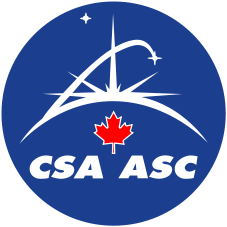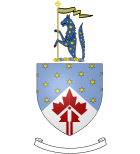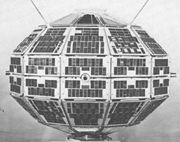Canadian Space Agency
| Canadian Space Agency | |
|---|---|
| Agence spatiale canadienne | |
 |
|
| Agency overview | |
| Formed | December 14, 1989 |
| Jurisdiction | Government of Canada |
| Headquarters | John H. Chapman Space Centre |
| Employees | 575 |
| Annual budget | CAD $373.5 million (2007) |
| Minister responsible | Tony Clement, Minister of Industry |
| Agency executive | Steve MacLean[1], President |
| Website | |
| http://www.space.gc.ca | |
The Canadian Space Agency (CSA or, in French, l'Agence spatiale canadienne, ASC) is the Canadian government space agency responsible for Canada's space program. It was established in March 1989 by the Canadian Space Agency Act and sanctioned in December 1990. The Chief Executive Officer of the agency is the President who reports to the Minister of Industry.
The headquarters of the CSA is located at John H. Chapman Space Centre in Saint-Hubert, Quebec. The agency also has offices in Ottawa, Ontario at the David Florida Laboratory (which is mainly an engineering installation) and small liaison offices in Washington, D.C.; Paris, France; Cape Canaveral, Florida; and Houston, Texas.
The agency is a relatively modest federal establishment, with only 575 employees and a rotating student population of about 100 interns or summer workers. Most of the staff is at the Chapman Centre.
Steve MacLean was named as president of the Canadian Space Agency on September 2, 2008.[2]
Contents |
History
With the launch of Alouette 1 in 1962 Canada became the third country to put a man-made satellite into space. The mission was successful beyond expectations, for although it was scheduled to proceed for one year, it in fact lasted for ten. This prompted further study of the ionosphere with the international ISIS program, which in 1993 was designated an International Milestone of Electrical Engineering by IEEE. Canada has never had any domestic launch capabilities of its own. While Alouette 1 was entirely built and funded by Canada, it was launched by the American National Aeronautics and Space Administration (NASA) from Vandenberg AFB in California.
Another Canadian first was the launch of Anik A-1 in 1972, making Canada the first country in the world to have its own domestic geostationary communication satellite network.
Mission and mandate

The Canadian Space Agency Act is the Act of the Parliament of Canada which established the Canadian Space Agency. The Act received royal assent on May 10, 1990 and came into force on December 14, 1990.[3]
The Canadian Space Agency's mission statement says that the agency is committed to leading the development and application of space knowledge for the benefit of Canadians and humanity.
To achieve this, the CSA attempts to promote an environment where all levels of the organization:
- pursue excellence collectively
- advocate a client-oriented attitude
- support employee-oriented practices and open communications
- commit themselves to both empowerment and accountability
- pledge to cooperate and work with partners to mutual benefit
Presidents of the Canadian Space Agency
- March 1, 1989 -1992[4] - Larkin Kerwin
- May 4, 1992-July 15, 1994 - Dr. Roland Doré
- November 21, 1994 - William MacDonald (Mac) Evans
- September 28, 2001 - Marc Garneau
- April 12, 2007 - Larry J. Boisvert
- January 1, 2008-September 2, 2008 - Guy Bujold
- September 2, 2008–present Steven MacLean[5]
Cooperation with other national agencies
The CSA has several formal and informal partnerships and collaborative programs or agreements with space agencies in other countries, such as NASA, ESA and JAXA, ISRO.
Since January 1, 1979 Canada has had the special status of a cooperating state with the ESA, paying for the privilege and also investing in working time and providing scientific instruments which are placed on European probes. On June 21, 2000 the accord was renewed for a fourth period, this time for 10 years. By virtue of this accord Canada takes part in ESA deliberative bodies and decision-making and in ESA's programmes and activities. Canadian firms can bid for and receive contracts to work on programmes. The accord has a provision specifically ensuring a fair industrial return to Canada. The head of the Canadian delegation to ESA is the president of the Canadian Space Agency. As of February 2009, there are currently 30 Canadians that are employed as staff members at ESA. (Distributed over various ESA sites: 20 at ESTEC; 4 at ESOC; 4 at ESA HQ; 2 at ESRIN).
The CSA visited the China National Space Administration in October 2005 and planned to reach a deal soon to put Canadian scientific instruments in two Chinese satellites. There was also speculation about China in the future perhaps wanting the Canadarm2 technology for its planned space station, but as of 22 October 2005, the CNSA has not raised the possibility.
Canadian Space Program
The Canadian Space Program is also administered by the Canadian Space Agency. Canada has contributed technology, expertise and personnel to the world space effort, especially in collaboration with NASA and ESA.
Astronaut Julie Payette is Chief Astronaut of CSA.
There have been three requirement campaigns to find astronauts for the CSA. The first, in 1983, produced Roberta Bondar, Marc Garneau, Robert Thirsk, Kenneth Money, Bjarni Tryggvason and Steve MacLean. The second, in 1992, produced Chris Hadfield, Julie Payette, Dafydd Williams and Mike Mackay.[6]
On May 13, 2009 it was announced that in the third national requirement campaign two new astronauts had been chosen for future space flights. They are Jeremy Hansen of Ailsa Craig, Ontario and David Saint-Jacques, of Quebec City, Quebec.[7]
In addition to its astronauts, some of the most notable Canadian technological contributions to space exploration are the Canadarm on the Space Shuttle as well as the Canadarm2 and the rest of the Mobile Servicing System on the International Space Station. The Canadarm and Canadarm2 are assisted by the Advanced Space Vision System which allows more efficient use of the robotic arms. Another example is the Orbiter Boom Sensor System, which is an extension of the Canadarm used to inspect the Space Shuttle's thermal Protection System for damage while in orbit.
With the successful launching of Radarsat 2 in December 2007 and near completion of Canada's C$1.4 billion contribution to the ISS the agency in early 2008 found itself with no major follow on projects. This fact was highlighted by Marc Garneau, Canada's first astronaut and former head of the CSA who in the fall of 2007 called upon the Canadian government to develop and institute a space policy for Canada.
Modest steps have been taken to resolve this problem. In November 2008, the Agency signed a $40 million 16-month contract with MacDonald Dettwiler and Associates Ltd. of Vancouver to begin the design of the RADARSAT Constellation (3 satellite) earth observation mission. In the 2009 Federal budget, the agency was awarded funding for the preliminary design of robotic Lunar/Martian rovers. However the fact remains that the Agency is without overall direction and that the support of the government of Canada is grudging at best. As of 2009 funding remains stagnant at about C$350,000,000 a year. As of late, the CSA has been researching locations in Cape Breton Nova Scotia and Fort Churchill Manitoba for a possible launch site for the CSA. This would allow the CSA the ability to launch satellites and future spacecraft, for the first time, into orbit without the reliance of other "outside" facilities.[8]
In 2009 the CSA announced the names of two new astronauts selected for the Astronaut Corps, Jeremy Hansen, a fighter pilot with the Canadian Forces and David Saint-Jacques a doctor. Although Space Shuttle flights will be made by Bob Thirsk (a six month long duration mission aboard the ISS) and Julie Payette in 2009, there are no plans for flights by these two new astronauts or other Canadian astronauts for at least five years.
Canadians in space
Nine Canadians have participated in 13 NASA manned missions and two Soyuz ones:
| Name | Launch Vehicle | Mission | Launch date | International Space Station Expedition | Notes |
|---|---|---|---|---|---|
| Marc Garneau | Challenger | STS-41-G | October 5, 1984 | First Canadian in space | |
| Roberta Bondar | Discovery | STS-42 | January 22, 1992 | First Canadian woman in space | |
| Steven MacLean | Space Shuttle Columbia | STS-52 | October 22, 1992 | ||
| Chris Hadfield | Atlantis | STS-74 | November 12, 1995 | Only Canadian to visit Mir | |
| Marc Garneau | Endeavour | STS-77 | May 19, 1996 | First Canadian to return to space | |
| Robert Thirsk | Columbia | STS-78 | June 20, 1996 | ||
| Bjarni Tryggvason | Discovery | STS-85 | August 7, 1997 | ||
| Dafydd Williams | Columbia | STS-90 | April 17, 1998 | ||
| Julie Payette | Discovery | STS-96 | May 27, 1999 | First Canadian to visit International Space Station (ISS mission) | |
| Marc Garneau | Endeavour | STS-97 | November 30, 2000 | ISS mission, Return to space (third visit) | |
| Chris Hadfield | Endeavour | STS-100 | April 19, 2001 | ISS mission, Return to space (second visit), First spacewalk by a Canadian | |
| Steven MacLean | Atlantis | STS-115 | September 9, 2006 | ISS mission, Return to space (second visit), Canadian Spacewalk | |
| Dafydd Williams | Endeavour | STS-118 | August 27, 2007 | ISS mission, Return to space (second visit), Canadian Spacewalk | |
| Robert Thirsk | Soyuz-FG | Soyuz TMA-15 (Союз ТМА-15) | May 27, 2009 | Expedition 20, Expedition 21 | Return to space (second visit), First flight on a Russian launch vehicle by a Canadian, first Canadian on a permanent ISS crew |
| Julie Payette | Endeavour | STS-127 | July 15, 2009 | ISS mission, First Canadian woman to return to space, First time two Canadians were in space simultaneously (with Thirsk), Largest gathering (13) of humans in space, as 7 STS-127 arrivals join 6 already on ISS, Largest gathering (5) of nationalities in space, as USA, Russia, Japan, Canada, and Belgium have astronauts together on ISS | |
| Guy Laliberté | Soyuz | Soyuz TMA-16 (Союз ТМА-16) | September 30, 2009 | First Canadian space tourist |
Note: Two former Canadian astronauts never flew in space; Michael McKay resigned due to medical reasons and Kenneth Money resigned in 1992, eight years after his selection.
Canadian satellites

| Name | Launched | Retired | Purpose |
|---|---|---|---|
| Alouette 1 | September 29, 1962 | 1972 | Explore the ionosphere |
| Alouette 2 | November 29, 1965 | August 1, 1975 | Explore the ionosphere |
| ISIS-I | January 30, 1969 | 1990 | Explore the ionosphere |
| ISIS-II | April 1, 1971 | 1990 | Explore the ionosphere |
| Hermes | January 17, 1976 | November, 1979 | Experimental communications satellite |
| RADARSAT-1 | November 4, 1995 | Still in use | Commercial Earth observation satellite |
| MOST | June 30, 2003 | Still in use | Space telescope |
| SCISAT-1 | August 12, 2003 | Still in use | Observe the Earth's atmosphere |
| RADARSAT-2 | December 14, 2007 | Still in use | Commercial Earth observation satellite |
| CASSIOPE | Scheduled for 2011[9] | CAScade, Smallsat and IOnospheric Polar Explorer |
Additionally, there are some commercial satellites launched by the telecommunications company Telesat Canada. These are the 13 Anik satellites (3 of which are still in use), the 3 Nimiq satellites (all currently used by Bell TV), and a satellite called M-Sat 1 launched April 20, 1996 at 22h36 UTC.
Further, technology/research satellites have been launched by the University of Toronto, including the CanX series.
Space Agency Locations
- John H. Chapman Space Centre - Longueuil, Quebec
- David Florida Laboratory - Ottawa, Ontario
- Fort Churchill - Manitoba
- Canadian Space Agency Building - Innovation Place Research Park - Saskatoon, Saskatchewan
See also
- List of space agencies
- Timeline of space travel by nationality
- Canadian government scientific research organizations
- Canadian university scientific research organizations
- Canadian industrial research and development organizations
- Canadian Geospace Monitoring
- Science and technology in Canada
References
- ↑ Astronaut Steve MacLean named Space Agency chief
- ↑ http://www.cbc.ca/technology/story/2008/09/02/csa-president.html
- ↑ Canadian Space Agency Act. Retrieved from http://laws.justice.gc.ca/en/C-23.2/text.html.
- ↑ [1]
- ↑ http://www.asc-csa.gc.ca/eng/about/milestones.asp
- ↑ http://news.sympatico.msn.ctv.ca/abc/home/contentposting.aspx?isfa=1&feedname=CTV-TOPSTORIES_V3&showbyline=True&date=true&newsitemid=CTVNews%2f20090513%2fnew_astronauts_090513
- ↑ http://news.sympatico.msn.ctv.ca/abc/home/contentposting.aspx?isfa=1&feedname=CTV-TOPSTORIES_V3&showbyline=True&date=true&newsitemid=CTVNews%2f20090513%2fnew_astronauts_090513
- ↑ http://www.ctv.ca/servlet/ArticleNews/story/CTVNews/20100328/space_cape_breton_100328/20100328?hub=TopStoriesV2
- ↑ http://mertensiana.phys.ucalgary.ca/projectschedule.htm
External links
- Official website
- Canadian Space Agency channel at YouTube
- SpaceRef Canada - Canada in Space
- Text of the Canadian Space Agency Act
|
|||||||||||||||||||||||||||||||||||||||||||||||
|
|||||||||||